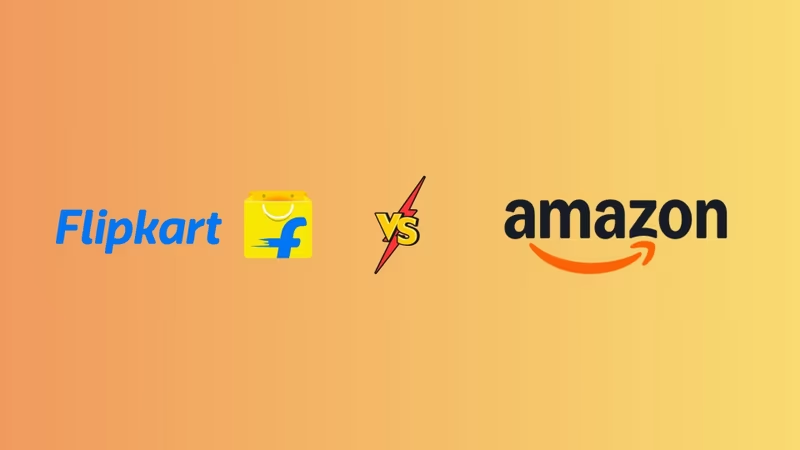The Indian shopping experience has changed dramatically over the past few decades, now providing amazing customer experiences that were not there before.
Earlier, people had to go to the market to buy products, then had to haggle about the price and finally had to worry about the exchange.
However, all this changed when the e-commerce industry emerged, enhancing the shopping experience for consumers by offering home delivery of products with discounts and free exchange and returns.
Two players, particularly Flipkart and Amazon, have dominated the Indian e-commerce industry. Let's deep dive into these two e-commerce giants.
Company Overview
Flipkart: India’s Homegrown Giant
Founded in October 2007 by ex-Amazon employees Sachin and Binny Bansal in Bengaluru, Flipkart started as an online bookstore and expanded across categories, logistics, fintech, and digital media.
Acquired by Walmart in 2018, Flipkart commands approximately 48% of India’s e-commerce market share.
Amazon India: The Global Giant
Entering India in 2013 with an investment of $10 billion, Amazon brought with it deep tech, logistics, and customer-centric playbooks.
It rapidly expanded its service in India from e-commerce websites to offering various services like Prime, Amazon Pay, Fresh, and a vast seller network, and it built a strong local presence. It currently holds about 24% of India’s e-commerce GMV.
E-Commerce Industry Overview:
India’s e-commerce market is valued at approximately $125 billion in 2024 and is projected to hit $325 billion by 2030 at a CAGR of 21%.
This expansion is driven by increased spending from affluent and middle-class households, which is also supported by rising smartphone penetration, low-cost data, and expanding Tier II/III reach.
Quick commerce, retail media, and fintech integrations are reshaping the e-commerce industry.
Check out our detailed comparison of Groww vs. Zerodha.
Brand Teardown
Financial Snapshot & Market Metrics (FY 2023–24)
|
Metric |
Flipkart India (Marketplace Arm) |
Amazon India (Seller Services) |
|
Market Valuation |
$35 B |
$2.39T (Market Cap) |
|
Revenue (Marketplace) |
₹25,406 cr (+14% YoY) |
|
|
Net Loss |
₹2,358 cr |
₹3,470 cr |
|
Employees |
21,000+ |
38,000+ |
|
MAU (India) |
180M |
200M |
|
No. of orders |
24 Lakhs (per day) |
26 Lakhs (per day) |
|
Market Share (GMV) |
48% of Indian e‑commerce |
31% of Indian e‑commerce |
|
Product Listing |
200 million SKUs in India |
170 million SKUs in India |
|
Owner |
Walmart Inc. (77%) |
Amazon.com, Inc. (USA) |
|
Total GMV |
$8.5B |
$18 B |
|
Last Funding round |
$1 billion round (May 2024) led by Walmart and Google |
Internal Funding Only ($233M investment in India (2025)) |
Strategic and Ecosystem Comparison
|
Strategic Area |
Flipkart |
Amazon India |
|
CEO |
Kalyan Krishnamurthy |
Samir Kumar |
|
Market Entry Strategy |
Founded in 2007, it has been in partnership with various companies, including Myntra, PhonePe, and Walmart (through stakeholding) |
Entered 2013 with a huge investment, currently scaling via Prime, AWS, logistics, and payment bank. |
|
Ecosystem Components |
|
|
|
Fintech Partnerships |
|
|
|
Subscription and benefits |
Flipkart Plus Membership allows you to access the sale earlier and membership discounts and coupons. |
Amazon Prime Membership allows you earlier delivery, earlier access to sales and membership discounts. |
|
Tech & Logistics |
Hyperlocal fulfilment, 10-minute delivery through minutes and leverages a logistic ecosystem under Ekart. |
AWS-powered backend, built end-to-end infrastructure, and control over delivery timeline & experience. |
|
Sales Events and Retention |
Big Billion Days, summer sales, vernacular UI, and membership discounts. |
Great Indian Festival sales, quality control, faster delivery, and content bundling. |
|
Ad & Monetization |
Ad revenue, commissions, PhonePe merchant fees, and fintech fees |
Prime subscriptions, ad revenue, commission, payment aggregator fees |
|
Regulatory Risk |
Under scrutiny by CCI/ED for inventory control and seller dominance |
Similar regulatory exposure via antitrust probes into marketplace dominance |
Download the Jar app and save money in 24k digital gold instantly. Save as you like it—daily, weekly, or monthly.
Final Thoughts
Flipkart, India’s homegrown hero, has gained consumer attention with mind-blowing discounts and a wide range of products, thus spearheading the market.
While Amazon started with rapid expansion through huge investment, ecosystem play has been dominant in the industry.
The Indian e-commerce industry is expected to boom in the coming few years as the shopping trend of Indian consumers changes.
With new players coming into the market and the rapid expansion of quick commerce, it won’t be straightforward for the giants in the industry to dominate.
With growing demand for online shopping and the tussle of players in the market, it would be consumers who would benefit the most.










